When I was a child growing up in Kwa-Zulu Natal, elephants had not yet been introduced into our provincial parks, and so apart from sighting elephants on two brief trips to Kruger National Park, it was only in the early 1990s on slightly more extended trips to Botswana that we spent more time observing elephants – usually from our vehicle but sometimes too as they walked by, or even into, our camping site.
On our first visit to Chobe National Park in Botswana (in 1990), during our first most intense elephant experience we neither saw nor heard them – but we smelt them. After driving through treacherous mud from a remote camp, we settled down on a straight and sandy road that was still cool and damp in the low light of the early morning. We came to a section of road that extended for well over a kilometre where it was evident that a large herd of elephants had spent quite some time lying down. The soft sandy road had signs of digging and scuffing and elephant-shaped and -sized depressions in the road, making it bumpy to drive along.
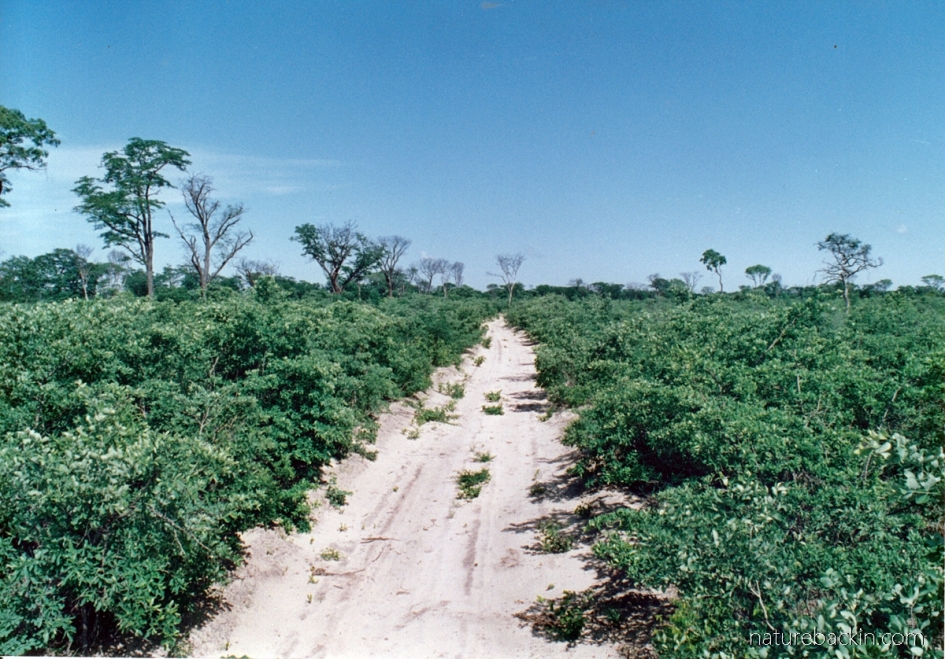
A view of a different section of the sandy road that elephants had evidently slept on the previous night. This photo was taken further along and later in the day when the sun was high
At one point we stopped, getting out of the vehicle somewhat cautiously to examine the depressions in the road left by the elephants and found impressions of wrinkled elephant skin clearly delineated in the damp sand. Mostly the elephants appeared have been lying down on their sides, each leaving a clear imprint. To our surprise when we touched the imprints they were still warm from the elephants’ bodies – the unmarked sand around the depressions by comparison felt cool to the touch. We could also smell a pungent animal smell not just from the fresh dung, but elephant body odour seemed to linger in the sand where they had lain and in the calm morning air.
We looked around us somewhat incredulous – clearly dozens of elephants were very nearby but we did not hear a sound nor catch sight of them. We went on, driving slowly and keeping our eyes peeled for elephants, feeling somewhat anxious actually. We saw several trees that had recently been pushed over by the elephants for easier browsing or to strip the bark. A few of these had fallen across the road and blocked our way. We had to get out of our vehicle, which of course we did with extreme wariness, to walk around each such obstacle to navigate a safe way of driving around it.

Later on in our trip we saw a small herd of elephants approaching through the mopani trees. It was such a thrilling sight to stop and wait to watch them approach on silent feet, with the adults showing a high level of alertness at our presence
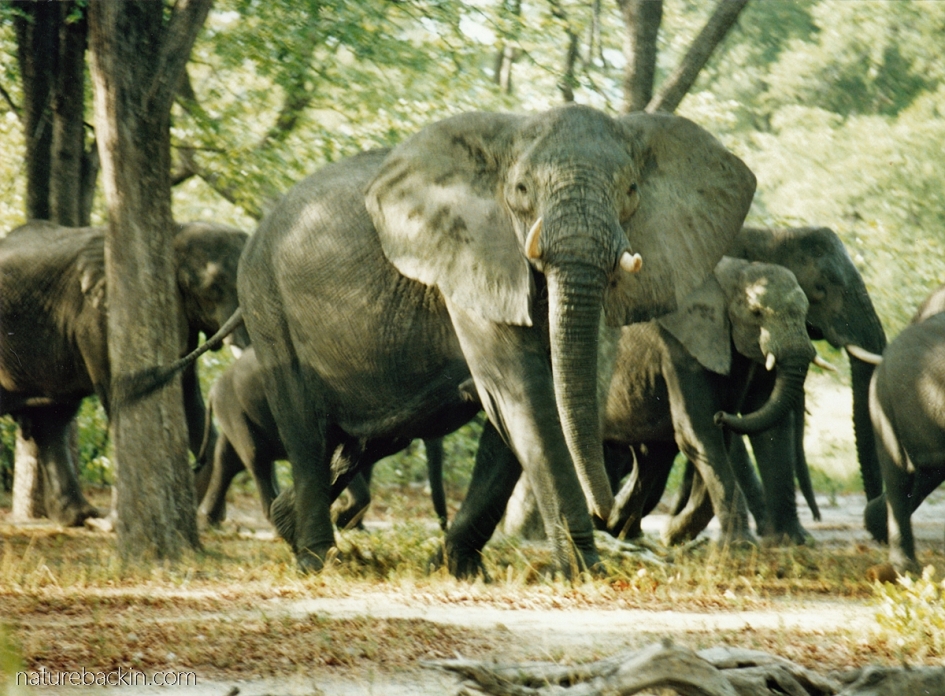
This elephant was keeping an especially vigilant eye on us. These photos are scanned from old prints, but despite the poor quality I think they still convey something of the atmosphere
That elephants can make a kind of rumbling noise has been well known for decades, although it was believed that these penetrating noises were stomach rumbles. I certainly grew up with that information even though I had not yet heard elephant rumbles myself.
The first time my husband and I heard elephant rumbles it was quite an introduction. Back in 1990, we were camped at a place called Serondela, a small camping site inside the Chobe National Park, Botswana, that overlooked a calm stretch of the Chobe River as it gently flowed below a high stretch of river bank that formed a small cliff. We were driving a hired bakkie (small pick-up truck) with game-viewing seats on the back (the canopied vehicle that we should have been given had been written off in an accident the day before we arrived).

From our Serondela camping site in 1990 we had this view over the Chobe River to the flood plain beyond – an area that was frequently thronged by dozens of elephants at dusk in particular. Sadly, the Serondela camping site is no longer used – Ihaha camping site is used in its place

It was very difficult to photograph the elephants on the flood plain because of the low light at dusk, and also impossible to capture the sheer numbers spread along the river and adjacent wetlands, but perhaps this photo conveys some impression
After watching and taking some photographs of the elephants along the Chobe River at dusk, we returned to our solitary campsite overlooking the river and we started making some preparations for supper. Night had fallen but the sky was bright with stars and illuminated by a rising sickle moon.
All of a sudden the chirping of crickets and other small nocturnal sounds were breached by a tremendous and penetrating grumbling-growling sound. What on earth was that?! We stopped what we were doing and instinctively climbed onto the game-viewing seats on the back of the bakkie (at night we kept our baggage and food inside the cab of the bakkie – safer than on the open back or in our flimsy tent).
The intermittent growling sounds multiplied – it sounded as if a fantastical herd of growling over-sized leopards was approaching! Then an elephant, large even by elephant standards, came and stood on the road near our bakkie. It was so near and so tall that its bulk blocked out part of our view of the starry sky. We practically held our breath and remained as still as possible, comforted by the fact that that the elephant knew full well we were there and that he decided to approach us anyway.
It seemed that this elephant was acting as a sentry, keeping tabs on us as the rest of the herd, while making continual growling and rumbling sounds, passed us by walking steadily across a flat grassy area that flanked the high river bank. We were camped between the drop to the river and the sandy track that ran through the camp parallel to the river bank. The elephants passed on the other side of the sandy track – a procession of hardly perceptible dark and bulky shapes, with a few of the closer ones discernibly elephants showing the occasional glint of pale tusks. Their footfalls were silent, but they continued rumbling as they walked passed.
Once the herd had gone by the sentry slowly moved off, passing only a few metres from where we sat in silent respect and awe.
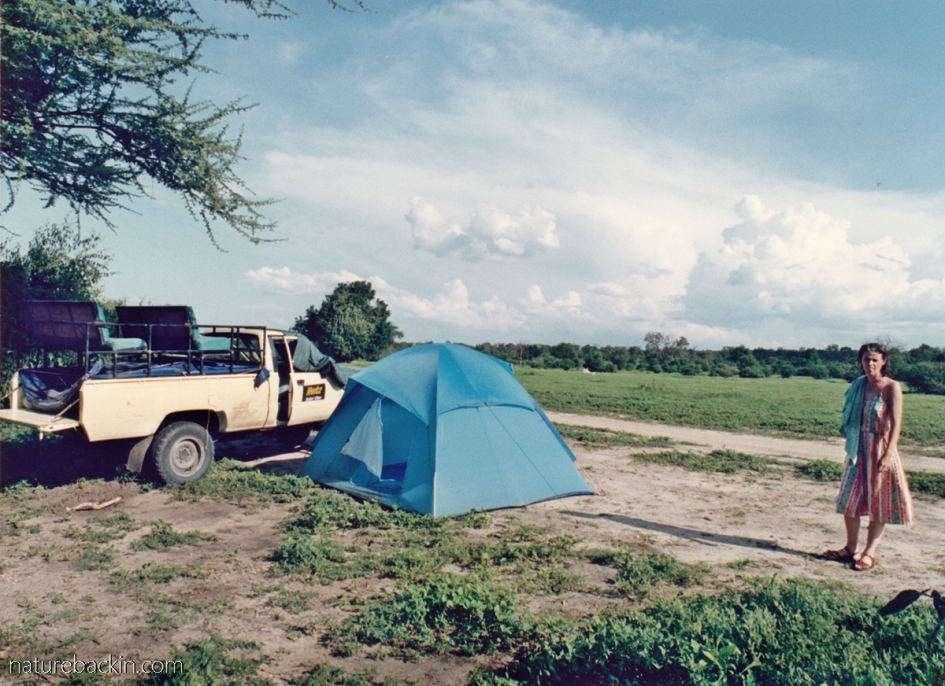
Me at our campsite the next morning – the sandy track where the sentry elephant stood is visible behind me and the grassy plateau resembling a large field is where the rumbling herd of elephants passed by the night before. Our flimsy tent is next to the hired bakkie with its game-viewing seats visible on the back. Unseen to the left the ground falls away to the Chobe River below
That morning we consulted the guide book we had with us, A Field Guide to the Large Mammals of Africa (1972 Dorst & Dandelot), to find out about elephant growling and rumbling sounds. In the guidebook it is noted that highly sociable elephants “can be very noisy and produce a variety of sounds to communicate” and that calls “indicate alarm, identification, distress or keeping in touch” and that “most signals take the form of a rumble issued either through the trunk or mouth”. In addition, elephants can make high pitched and loud trumpeting sounds signalling distress and short, sharp blasts of shrill trumpeting when charging (p.156).
The suggestion that some elephant rumblings are produced by the stomach and digestive processes Dorst and Dandelot state is unlikely as the sounds are controlled at will. It is more probable, they say, that “these noises are made by the vocal organs and that elephant keep in touch with each other by this growl” (p.156).
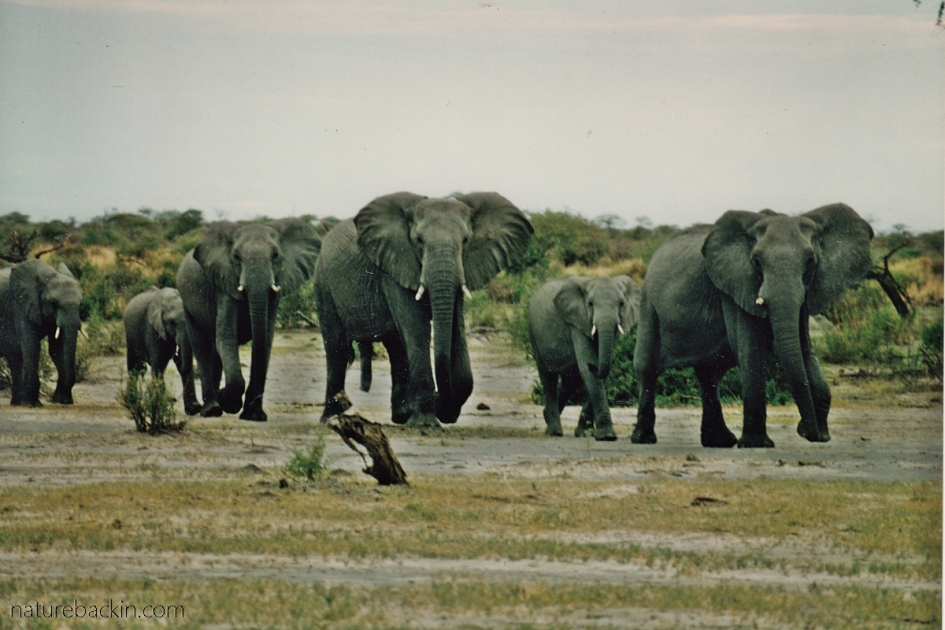
A group of elephants on the move in Chobe National Park, Botswana
That the rumbles and growls that elephants make when communicating are produced by their vocal organs has since been confirmed. As already mentioned, in addition to rumble vocalisations there are many other elephant calls of higher frequencies such as trumpeting, snorts, barks and cries.
See the link below for a recording from the Elephant Voices Elephant Ethogram, which is a library of sound and video recordings of elephant behaviour and communication. In this recording a group of elephants emit bonding-rumbles and social trumpeting after the group had engaged in defensive action against another group of elephants https://elephantvoices.org/elephant-ethogram/search-portal/behavior?id=353
Some elephant rumbles are within the human auditory range, but it has been discovered that many elephant rumbling sounds are of such a low frequency that their low pitch is below the range of human hearing. Such low-frequency sounds are referred to as infrasound. Although the pitch of infrasound calls is below the threshold of human hearing, under certain conditions humans may sense them as pulsations in the air. However, humans are generally completely oblivious of elephant infrasound communication and so until recently humans have been unaware of how vocal elephants actually are.
In 1984, Katy Payne, an acoustic biologist who had previously been involved in recording the infrasound calls of whales, realized while observing captive elephants in a zoo that the elephants were using infrasound to communicate. It was partly her awareness and knowledge of whale infrasound communication that contributed to her discerning the use of infrasound in elephants. For a fascinating account by Katy Payne of how she discovered and first recorded elephant infrasound and of subsequent research with wild elephants, do watch this illuminating video (duration 12 minutes 45 seconds), which is available on the Elephant Listening Project website, https://elephantlisteningproject.org/katy-payne-on-elephants/
After Payne’s initial work on infrasound communication with captive elephants, she worked at Amboseli National Park in Kenya together with Joyce Poole. In 1975 Joyce Poole had joined the Amboseli Elephant Research Project started by Cynthia Moss, who had previously worked with elephant researcher Iain Douglas-Hamilton.

On our trip to Chobe National Park in 1990 we stopped to watch a small group of elephants browsing next to the road. We were kept under close scrutiny by one of the adults. Adult elephants with young calves in their group are extremely protective of the youngsters
Prior to the discovery of infrasound calls in elephants some elephant behaviour seemed to be almost uncanny. How did elephants seem to know at a distance where other elephants were, and even how to meet up with them? Some observers even speculated that elephants must use some form of extrasensory perception. But as research has since demonstrated, infrasound can travel several kilometres and be detected by attentive elephants and so we now know that elephants are able to communicate effectively over long distances.
Not only do elephants have a distinct vocabulary of calls, but individual elephants are able to distinguish and recognize the voices of other individual elephants.
In a 2012 research project, a team of researchers at the University of Vienna was able to show that elephants produce infrasound by exhaling air from the lungs over the vocal folds (chords) in the larynx, which is the same mechanism that humans use when singing. The immense size of the elephant larynx produces the very low notes (see https://www.sciencedaily.com/releases/2012/08/120803103421.htm).

A small family group of elephants waiting near a busy waterhole at Addo Elephant National Park. Although this group of elephants is obviously waiting, it is possible that they are also listening to elephant vocalisations that humans are unable to hear
In a further development in our knowledge of elephant infrasound communication it has been found that infrasound calls are transmitted through the air but also simultaneously the sound is propagated through the ground, where it travels more slowly than through the air. Elephants are able to discern proximity through the timing differential of the airborne signal and the seismic signals that they also detect.
Back in the late 1990s, researcher Caitlin O’Connor-Rodwell pioneered research into elephant seismic communication. Much as Katy Payne’s previous work with whales better prepared her for appreciating elephants’ infrasound capabilities, O’Connor-Rodwell’s previous work with planthoppers, insects that communicate seismically by sending out vibrations on plant stems, prepared her for her observations of elephants picking up seismic signals through their feet and also through their trunks. Research has demonstrated that elephants respond with understanding to recordings of specific calls played seismically, that is through the ground.
Elephants have receptors in the fatty deposits in their feet that can transmit the seismic signals through the skeletal structure into the bones of the inner ear, and receptors at the tips of their trunks may also transmit seismic signals to the brain.

The skeletal bones of an elephant’s foot are not that different to our own, but the heel of the foot is supported by a dense fatty cushion. Within this dense fatty pad are receptors that play a role in the elephant’s ability to detect seismic communications. The little Cape Wagtail in the photo is unaware of all of that
Elephant researchers have observed how elephants on the move can suddenly freeze and stop as a group, listening with a high degree of intensity as they pay attention to what is likely to be communication from distant elephants.
So if you ever have the opportunity to observe elephants in the wild or even in captivity, it is interesting to be alert to the idea that they may be calling or listening to infrasound that is too low for us to hear.
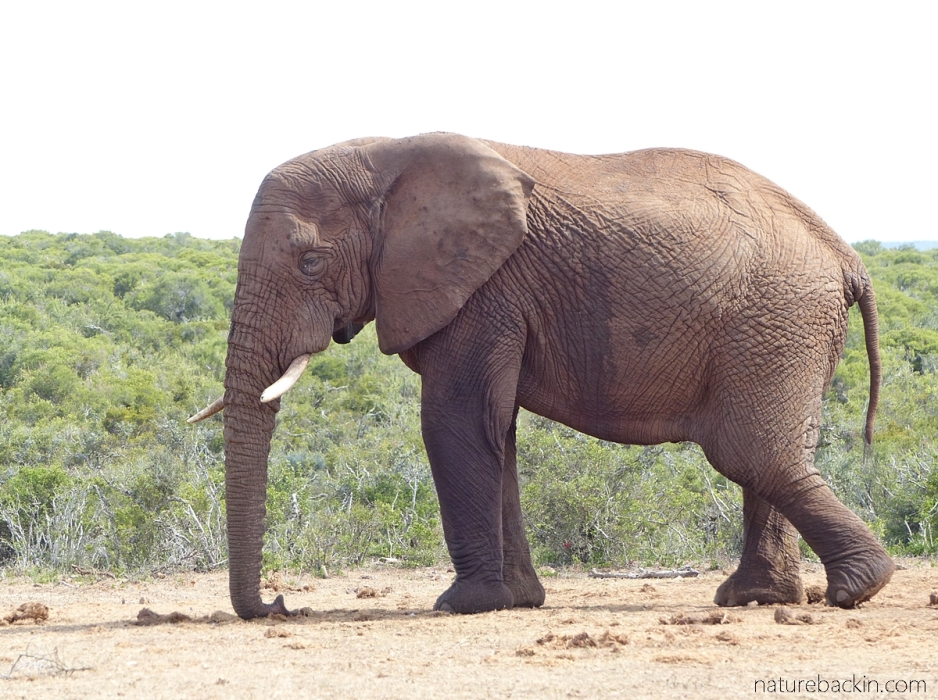
We observed this elephant standing apart from a group elephants drinking at the Spekboom waterhole at the Addo Elephant National Park. He stood there for several minutes apparently concentrating while holding the end of his trunk to the ground and tipping one hind leg onto its toe
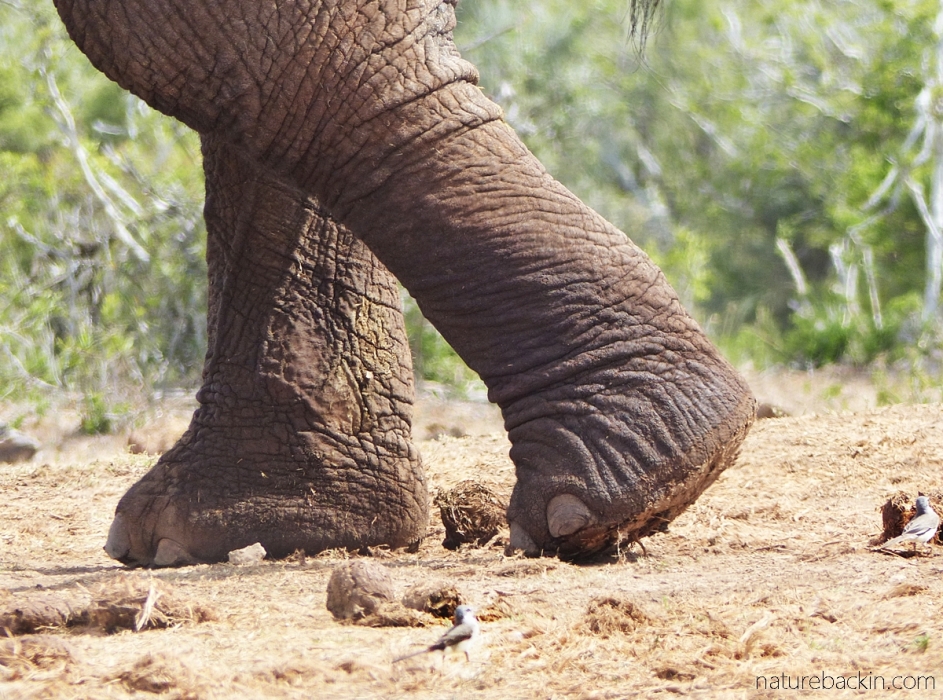
A close-up of the elephant’s hind feet

This photograph was taken a full three minutes after the previous two photographs. During this time the elephant continued to stand attentively, shifting his left hind leg onto the heel. The vibration receptors are more concentrated in the front and also at the heel of the foot
Of course in addition to acoustic and seismic communications elephants can also communicate using chemical, visual and tactile modes of communicating, using their senses of smell, sight and touch. It is most intriguing to watch elephant body language and posturing when they are interacting, and their communication and connection with each other through touch is something that really appeals to us as human observers of these highly social animals.

On a visit to Addo Elephant National Park in 2016, we watched two young male elephants who were engaged in some friendly sparring near at waterhole. Their interaction included much gentle touching. Here one elephant is delicately touching an eye of his sparring partner using the tip of the trunk

To human eyes this gentle embracing with their trunks by two elephants who are about to be joined by a young baby is an affecting expression of affection and companionship between elephants

In the heat and dust of a melee of dozens and elephants coming and going from a large and busy waterhole at the Addo Elephant National Park, this baby, surrounded by protective adult and sub-adult elephants in its family group, gained extra reassurance through tender trunk contact with its mother
Sources and interesting resources
Dorst, Jean & Dandelot, Pierre. 1972. A Field Guide to the Large Mammals of Africa. (2nd ed., reprinted 1984). London: Collins.
Elephant Listening Project. 2017. Katy Payne on Elephants. A video interview with Katy Payne produced by Charlie Walcott, April 17. https://elephantlisteningproject.org/katy-payne-on-elephants/
Elephant Voices. [n.d.] Seismic communication. https://elephantvoices.org/elephant-communication/seismic-communication.html
Kennerson, Elliot. 2018. How elephants listen with their feet. KQED, July 17. https://www.kqed.org/science/1926248/how-elephants-listen-with-their-feet. Includes an interesting video
O’Connell-Rodwell, Caitlin E. 2007. Keeping an “Ear” to the Ground: Seismic Communication in Elephants/ Physiology, vol. 22 (4), pp. 287-294. https://journals.physiology.org/doi/full/10.1152/physiol.00008.2007
Phys.org. 2005. Scientists unravel the secret world of elephant communication. Phys.org, May 23. https://phys.org/news/2005-05-scientists-unravel-secret-world-elephant.html
University of Vienna. 2012. Mystery of elephant infrasounds revealed. ScienceDaily, August 3. https://www.sciencedaily.com/releases/2012/08/120803103421.htm
Posted by Carol

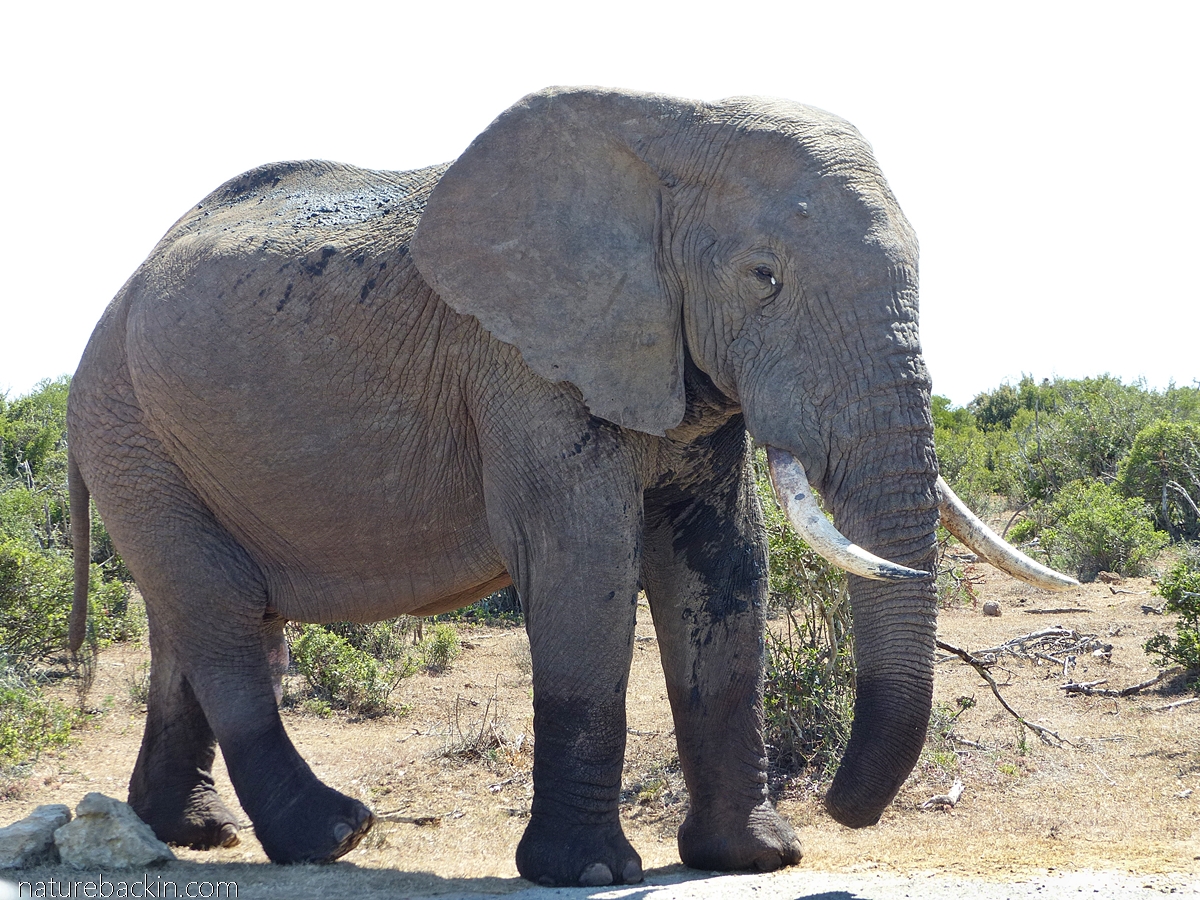





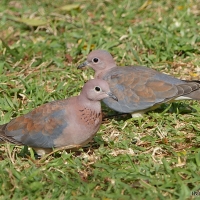
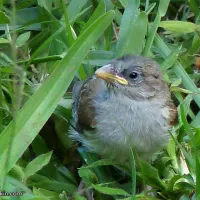
September 26, 2021 at 8:25 pm
This was an utterly fascinating post, Carol!! Thank you so much for sharing all this valuable information about elephants! I must confess that I was holding my breath during some of your early descriptions of your close-up encounters with the elephants! Thank you also for sharing the links and the video. The researcher’s reference to the humpback whales studies made me think of a new book I am reading for our Audubon book group, called Becoming Wild, by Carl Safina. One of the species he writes about is the sperm whale and their language/communication/culture.
LikeLiked by 1 person
October 1, 2021 at 10:56 am
Thanks Carol and I am glad you enjoyed the links and the video. Thanks very much for drawing my attention to Carl Safina. I see he has done a couple of TED talks that I will watch and then see if I can access some of his books, The book ‘Becoming Wild’ sounds most interesting.
LikeLiked by 1 person
September 5, 2021 at 5:05 pm
I’ve had to wait a while before I could read this post, Carol, but it was totally worth the wait. I was thrilled by the account of your encounters with elephants and astonished by the infomation on communication. I had no idea. They are wonderful creatures.
LikeLiked by 2 people
September 5, 2021 at 5:45 pm
Indeed they are wonderful creatures and we have much to learn from them and about them it seems.
I hope all is okay with you and your family. Take care.
LikeLiked by 2 people
September 2, 2021 at 7:38 pm
Carol, this was a fascinating and informative essay and so very well written, thank you. I have had the immense pleasure of hearing wild elephants rumble, a few times. And some fabulous elephants interacting along and in the Chobe River. Your descriptions and photos here are so wonderful, especially that series of the elephant with the trunk on the ground and its hind foot changing positions. Herds of elephants are endlessly interesting to watch, and you captured that well in numerous photos. I have never heard of them receiving seismic vibrations, and found that endlessly interesting. And the camping experience you and your husband had on the Chobe was gripping. I find it endearing to watch female elephants clustered with a few of their young, and likewise, enjoyed hearing about all the female researchers you introduced here. Brilliant essay and much appreciated.
LikeLiked by 2 people
September 3, 2021 at 2:23 pm
Hi Jet – I think that seeing elephants along the Chobe River is one of the most magical places to see them. It is very different seeing them in areas where they have been reintroduced, often as traumatized orphans.
The seismic vibrations research is most interesting. You may be interested in seeing Caitlin O’Connors’s TED talk that is available online. It is interesting that many of the elephant researchers in the communications and behaviour field are women.
Thanks so much for your comments and I agree that watching elephants and their young is most endearing.
LikeLiked by 2 people
August 31, 2021 at 3:25 pm
What a beautiful and very informative post. Many thanks! 🌸
LikeLiked by 1 person
September 1, 2021 at 7:09 pm
Thank you very much, Debbie!
LikeLike
August 31, 2021 at 10:49 am
Absolutely fascinating.
LikeLiked by 1 person
September 1, 2021 at 7:14 pm
Their infrasound communication is a particularly fascinating dimension and reading about some of the research projects is also really interesting. It seems that there is still a lot to be learnt …
LikeLiked by 1 person
August 30, 2021 at 6:32 pm
So much to see and learn here! What astounding adventures you’ve had! It’s beyond my wildest dreams to see wild elephants moving in freedom such as you’ve observed.
Your older photos are so precious that there’s no need to apologize for the quality. They speak so much of things you’ve seen or experienced that most of us will never realize. I am so grateful that you’ve posted them here for us to enjoy!
That first image of the elephant’s foot also included a wonderful capture of a bird looking impossibly small next to that HUGE foot.
Now I’m off to listen to elephant rumbles….. 🤭🐘
It may take me awhile to get to your posts, but they’re always worth waiting for a chance to truly sit and enjoy!!! Thank you for sharing these.
Hope your husband is improving! 🙏
LikeLiked by 1 person
August 30, 2021 at 9:55 pm
Thinking back on some of our trips we have had some great adventures and tremendous experiences. We have been very fortunate and seeing wild elephants is particularly special.
It is nice to know that the older photos convey something of our experiences and I have enjoyed sharing these memories.
I hope you enjoy the elephant rumbles. I gather using headphones makes them easier to hear.
My husband’s shoulder is definitely improving thanks. I hope I can start catching up on blog reading this week!
LikeLiked by 1 person
August 28, 2021 at 4:33 am
Fascinating stuff and most informative. Elephants are so expressive and your photos capture this beautifully.
LikeLiked by 1 person
August 28, 2021 at 2:49 pm
They are so expressive and there is much to absorb and learn about them. Among the most remarkable is that they have such a sense of humour and at times can even have fun acting out in the presence of humans.
LikeLiked by 1 person
September 2, 2021 at 5:36 am
Got to love anything with a sense of humor!
LikeLiked by 1 person
September 3, 2021 at 2:10 pm
😊
LikeLiked by 1 person
August 27, 2021 at 11:49 pm
What a fascinating post! The information about communication, especially regarding their feet, is quite astonishing. I’m so glad you included older pictures, even if you felt they weren’t as clear as new technology. I think they added so much!
I am thinking of that expression, “You sound like a herd of elephants”, which I now realize SHOULD mean, “You are quiet”! 😉
Thanks again for yet another wonderful post.
Best,
Julie
LikeLiked by 1 person
August 28, 2021 at 2:45 pm
Thanks Julie. Interestingly and sadly, captive elephants, especially those living on concrete floors and in confined spaces, frequently suffer from foot infections that can prove fatal. Apparently the care of the feet of captive elephants is a complicated issue.
I am glad to hear that you liked the older photos – scanning from relatively small prints with the scanner I have is never that satisfactory, but I have so many old photos that are of interest.
I love your observation re the expression that assumes that a herd of elephants is noisy when in fact the contrary is the norm! 🙂🐘
LikeLiked by 1 person
August 27, 2021 at 9:42 pm
Thank you for sharing your fascinating photos and information about elephants. I learned so much and admire you for sleeping in a flimsy tent with these behemoths nearby!
Even before you mentioned whales, it is what I though of when you mentioned communication between different elephants. I find it enthralling to imagine what thoughts get communicated within the herd. And it’s amazing that they can move silently despite their size.
I hope that there will always be a place on Earth for wild elephants to thrive.
LikeLiked by 1 person
August 28, 2021 at 2:39 pm
Over time we bought our own bakkie and eventually a roof-top tent. We did feel more secure sleeping off the ground when nocturnal animals were close by!
It is interesting that whales and elephants both use infrasound. I gather that it is being found that there are other species too that call in infrasound, which had not been known before.
There is a lot more going on in many animal societies, including elephants, than we are ever likely to appreciate or understand!
Their silent footfalls of elephants are remarkable.
I also fervently hope we will allow elephants the space and security to thrive.
LikeLiked by 1 person
August 28, 2021 at 10:41 pm
I agree that there is much more for us to learn from the elephants, the whales, and so many other creatures.
Thanks again for this fascinating post.
LikeLiked by 1 person
August 27, 2021 at 8:09 am
What a fabulous post. I love the atmospheric account of your 1990 visit – that would have been excitement enough for a Friday morning. But what you tell us about elephant communication is fascinating: almost all of that is new to me. My only close encounters with elephants were in India, and only brief at that. And I never heard a thing. I guess much of what is known about African elephants is true of their Indian cousins too?
LikeLiked by 1 person
August 27, 2021 at 8:18 pm
The ongoing research into elephant communication is extremely interesting. African and Asian elephants do have a lot in common in the way they communicate and hear and discern seismic signals as far as I know. Katy Payne’s first elephant study group at the zoo she spent time at, was a group of Asian elephants. There are photos of them in the video interview link that is provided in my blog post btw.
LikeLiked by 1 person
August 28, 2021 at 9:51 am
Oh, I’d only skim-read this, so I’ll go back and give it further attention. Thanks.
LikeLiked by 1 person
August 28, 2021 at 2:53 pm
I only mention the Katy Payne video interview because that was where I saw some early work was with Asian elephants and I thought you might like to see the pics too – if you have the time of course.
So much to read/watch, so little time!!
LikeLiked by 1 person
August 28, 2021 at 4:02 pm
Yup!
LikeLiked by 1 person
August 27, 2021 at 5:17 am
This was worth the wait. Although we are very fortunate to have close encounters with elephants at Addo (not often enough, my inner voice chides me!), we have had our most interesting experiences in Botswana – a tale for another day. Dorst and Dandelot’s book became a well-thumbed reference book during our second visit there in 1972. I smiled at your description of the growling sounds making you think of leopards and thus hop onto the back of your bakkie, for we were once kept awake and very alert for a similar reason – only to discover the following morning that we had been surrounded by rutting impala!
LikeLiked by 1 person
August 27, 2021 at 8:11 pm
Thank you Anne. I am interested that you also have the Dorst and Dandelot book. I remember we bought our copy at the office and small shop at Ndumo Game Reserve many years ago. At the time it seemed to be a rather extravagant buy, so I am amused to see from the label that is still in the book that we paid R28.95 for it!
I can imagine how your imaginations must have run riot wondering what could have been making those strange growling, snorting, barking sounds. Impalas sound a lot more like predators red in tooth and claw than graceful antelope when rutting!
LikeLike
August 28, 2021 at 4:44 am
We bought our book in Maun.
LikeLiked by 1 person
August 28, 2021 at 2:50 pm
Evidently whoever was marketing the book knew where the target market was likely to be!
LikeLiked by 1 person
August 28, 2021 at 3:05 pm
I see ours cost R5.25.
LikeLiked by 1 person
August 30, 2021 at 9:42 pm
😊
LikeLike
August 27, 2021 at 4:39 am
Carol I love your blog, as always, full of interesting information and beautifully illustrated by your stunning photos. I am always in awe of the beautiful creatures, amazed by their almost silent passage through the bushveld and feel privileged that I have spent time watching them. Thank you! xxx
LikeLiked by 1 person
August 27, 2021 at 7:52 pm
Thanks so much Christeen. It is a huge privilege to have opportunities go watch elephants especially in environments where they feel relatively safe – sadly though their safety is far from being assured.
LikeLiked by 1 person
August 27, 2021 at 2:27 am
Absolutely fascinating stuff, Carol! And what a wonderful experience you had at Serondela!
LikeLiked by 1 person
August 27, 2021 at 7:48 pm
Thanks – the research into elephant communication and behaviour is particularly interesting and elephants are such charismatic animals. That experience at Serondela remains a vivid memory.
LikeLiked by 1 person
August 27, 2021 at 12:27 am
Fascinating animals and excellent, informative post, Carol. I’m grateful for the curiosity of researchers!
LikeLiked by 1 person
August 27, 2021 at 7:45 pm
Thank you Eliza, and I agree with what you say about researchers. And many wildlife researchers have become passionate advocates for conservation and broader issues too.
LikeLiked by 1 person